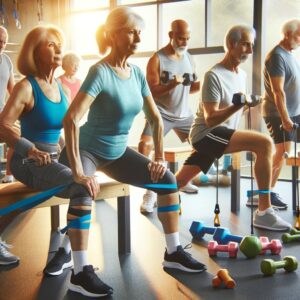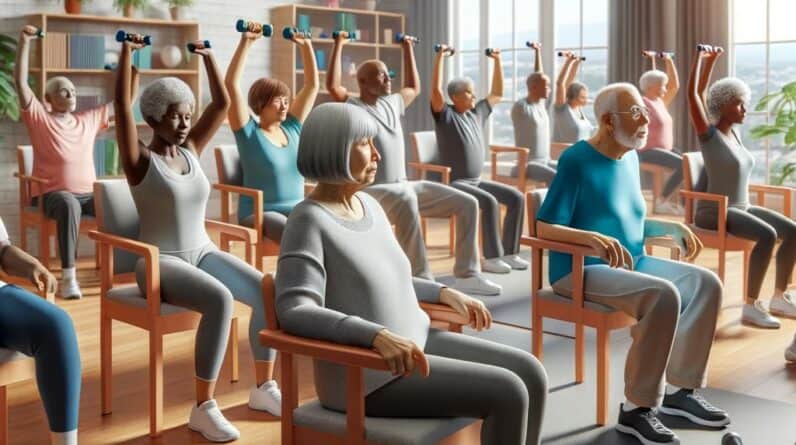

Dementia Discovery That is Leaving Doctors Speechless (Try This Tonight)
Better than Morphine For Joint Pain… Yet Safer Than Aspirin?
Retire With Freedom. Start Earning Extra Cash Today.
As I age, I understand more keenly the significance of maintaining my strength. It’s not just about preserving muscle mass, which naturally declines with time. It’s about sustaining my independence and enhancing my quality of life. Strength training for older adults like me isn’t simply a matter of vanity or a leisurely pursuit; it’s a vital component for a robust and functional existence.
Functional fitness, a concept that’s become central to strength training in later years, focuses on exercises that simplify the rigors of daily life. Lifting groceries, climbing stairs, or even getting up from a chair are tasks that can become increasingly difficult without adequate muscle tone and conditioning. Engaging in a regular strength training routine helps ensure that these day-to-day activities don’t become hurdles, allowing me, and seniors like me, to retain our independence.
Furthermore, one of the more overlooked aspects of strength training is its role in fall prevention. Building muscle isn’t just about strength; it’s about stability. As balance can deteriorate with age, maintaining muscle tone through targeted exercises can mean the difference between a close call and a debilitating fall. By prioritizing strength training, I equip my body not just to perform, but to protect itself.
Of course, adopting such a regimen comes with its challenges, especially when stepping into it for the first time in one’s golden years. There’s the initial hesitance, questions about safety, and the search for the best approach. It’s here that the guidance of seasoned professionals becomes invaluable. It sets the stage for not just embracing strength training but integrating it seamlessly into one’s lifestyle.
Guiding the Silver Strength Revolution: Experts and Influencers
A successful strength training journey isn’t a solo endeavor, especially when it comes to older adults. Expert guidance ensures a balance of efficacy and safety, creating a routine that respects the unique needs of aging bodies. Fitness trainers with a special focus on senior fitness bring a wealth of experience. They understand the nuances of how older muscles respond to exercise and can tailor programs that maintain or even improve muscle mass while minimizing injury risks.
It’s also worth considering the expert advice of physiotherapists. They’re the unsung heroes who can provide crucial insights into safe movement patterns and corrective exercises. This professional guidance is important for preventing unnecessary strain or overexertion, which is particularly vital as we age. Their prescribed exercises often play a key role in a comprehensive strength training routine, ensuring that each movement not only builds strength but also contributes to overall functional mobility.
Turning to the academic side of the senior fitness equation, gerontologists study the impact of various factors, including physical activity, on the aging process. Their research can shed light on how strength training may slow down or even reverse some signs of aging. The knowledge they share helps shape effective training strategies that can be woven into daily routines.
Finally, influential seniors in fitness serve as powerful motivators. They are living proof that age doesn’t have to be a barrier to strength and vitality. By sharing their achievements and advocacy, they inspire their peers to embrace strength training as a means to enhance their quality of life. Eager to follow in their footsteps, many seniors find the confidence to begin their strength training adventure, spurred on by the stories of those who have already reaped the benefits.
Designing Your Strength Training Path: Resources and Support
As an older adult committed to strengthening your body, knowing where to turn for guidance is essential. You don’t have to look far; a wealth of resources and support avenues are at your fingertips.
Senior fitness blogs and websites abound, offering a plethora of workouts, nutrition tips, and motivational stories specific to your age group. Before diving in, evaluate the credibility of these sites. Look for content created or vetted by certified fitness professionals with expertise in senior fitness.
Fitness apps are now catering to older adults with routines that consider your unique needs. These digital platforms are convenient and can offer a sense of structure and progression for your workouts. Choose an app that allows you to customize your experience based on your fitness level and goals.
Local gyms and fitness centers often offer classes designed for seniors. A good program should provide a mix of resistance training with proper rest periods, balance exercises, and stretching components. When you visit, make sure the staff shows understanding and patience, clarifying that they’re prepared to address the specific concerns of older adults.
Building a Community of Strength: The Institutional Backbone
When it comes to strength training for older adults, there’s more to the story than individual effort. Some institutions play crucial roles in supporting and advancing fitness among the elderly population. Senior wellness centers, for example, aren’t just about managing health issues; they are also vibrant communities encouraging physical activity through tailored strength programs.
Moreover, universities with specialized geriatric research programs are at the forefront of scientific inquiry into the effectiveness of strength training for seniors. These institutions often provide evidence-based guidelines that influence the design of workout programs suited to the needs of older adults.
Then there are healthcare facilities, which are critical in offering advice and supervised training to those who might have specific health concerns or need extra care. By understanding the complexities of aging bodies, healthcare professionals can develop strategies that not only build strength but also ensure safety and longevity in the fitness journey of older adults.
It’s essential to tap into these resources for a well-rounded approach to senior fitness. Participating in programs at senior wellness centers, following research-backed recommendations from universities, and seeking appropriate healthcare advice can collectively foster a robust environment for elders to safely engage in strength training.
The Locale of Fitness: Spaces That Encourage Elderly Strength Training
Finding the right environment for strength training can make a world of difference in motivation and consistency, especially for older adults. Community centers, retirement communities, and rehabilitation facilities are three types of locations fostering strength and resilience among the elderly through accessible fitness programs.
Community centers stand as beacons of inclusivity, providing a variety of fitness classes that often include strength training tailored for seniors. These local venues are not just about equipment and workouts; they’re about creating a supportive atmosphere where older adults feel connected and engaged.
Retirement communities have begun to recognize the immense value of integrating strength training into their residents’ lifestyles. By offering on-site gyms and organized fitness programs, these residential areas are revolutionizing the way we think about activity in later years. Such initiatives encourage residents to maintain their physical health, which directly impacts their independence and quality of life.
Rehabilitation centers cater to a slightly different aspect of senior fitness. They incorporate strength training as a critical part of recovery programs, helping older adults regain not only muscle mass and strength but also confidence in their physical capabilities after an injury or surgery.
With each of these locales contributing in their own unique way, they create a fabric of opportunities for older adults to discover the benefits of strength training. This sense of variety ensures that no matter one’s personal preference or needs, there’s a conducive space for maintaining physical health.
Celebrating Strength at Every Age: Events and Education
Seniors across the globe are rewriting the story of aging. More than ever, health and vitality extend into later years, and with it, a calendar teeming with senior fitness events. These gatherings aren’t just about competition; they’re about community. They offer a space where older adults celebrate their strengths and encourage one another.
Let’s talk about health and wellness workshops. They’re more than informative sessions; they’re catalysts for change. Conducted by experts, these workshops are pathways to a stronger, safer workout regimen, illuminating the nuances of strength training for those in their golden years. Participants leave not just with knowledge, but with the confidence to apply it.
Senior sports leagues offer a blend of camaraderie and healthy competition. They encourage regular physical activity, which is crucial for keeping muscles strong and minds sharp. Whether it’s a team sport or an individual endeavor, these leagues remind us that age is just a number when it comes to maintaining an active lifestyle.
The activities and events dedicated to senior strength training are more than just appointments on a calendar. They’re opportunities to learn, to grow, and to connect.
Accessible Strength: Tools for Elderly Fitness
A well-equipped toolbox is essential for any job, and strength training for older adults is no different. Selective use of the right tools can make the difference between a routine that’s both effective and enjoyable, and one that is discouraging or even unsafe.
Resistance bands serve as a versatile accompaniment to any workout. Why? They’re lightweight, adaptable to various fitness levels, and can be used to target nearly every muscle group. These bands ease the pressure on the joints, a vital factor for seniors who may struggle with arthritis or other joint issues.
Lightweights, specifically those that are easy to grip and maneuver, are also integral to a senior’s strength routine. By using dumbbells or wrist weights, older adults can improve muscle mass and bone density, which tends to wane with age.
The type of exercise machine matters, too. Machines that prioritize safety and are suited to the seniors’ physique can encourage regular use and prevent injury. For instance, recumbent bikes or seated elliptical trainers help maintain cardiovascular health while also engaging different muscle groups.
However, knowing which tools to use is only part of the equation. Equally important is learning HOW these tools can be integrated into a daily or weekly strength training routine. This is where our next section comes in, providing a bridge to ‘Looking Forward: Future Trends in Senior Fitness.’
Looking Forward: Future Trends in Senior Fitness

The landscape of fitness is constantly evolving, and the segment catering to older adults is no exception. In recent years, there’s been a noticeable shift towards more inclusive and accessible fitness solutions. Looking forward, we can anticipate several trends that may redefine strength training for older adults.
One significant trend is the increased focus on senior fitness within the industry. Fitness organizations and programs are beginning to recognize the growing population of active older adults and the unique opportunities this presents. There’s a clear trajectory towards more specialized workout programs that cater to the needs and limitations of seniors, with an emphasis on not just maintaining but improving quality of life.
Technological innovations are also likely to play a pivotal role in the evolution of strength training for seniors. From wearables that monitor vital stats to machines that adapt to the user’s range of motion and strength level, technology is making it easier and safer for seniors to engage in physical activity. As the tech becomes increasingly sophisticated, we can expect more personalized and effective training methods to emerge.
We’re also seeing a greater emphasis on preventive health, with strength training emerging as a key component. The healthcare community has begun to more strongly advocate for regular physical activity as a means to prevent a range of age-related issues. This shift in perspective is important because it recognizes the proactive role strength training can play in managing health, potentially reducing the need for more intensive medical intervention down the line.
Strength training is ripe for innovation, and as such, we should prepare ourselves to embrace new approaches and tools that will make it more engaging, effective, and enjoyable for older adults. From evolving fitness programs to advanced technological tools, the future of senior strength training is aimed at empowering older adults with the strength and confidence they need to enjoy a vibrant, independent life.
Building a Strength Training Regimen: A Step-by-Step Guide for Seniors
Embarking on a strength training journey might sound daunting at first—remember, I understand the confusion and concerns that can come with trying something new, especially later in life. But forging a path toward better health isn’t out of reach. With the right approach, it can be a rewarding and life-enhancing experience.
First, consult a professional. Seek out a fitness trainer specializing in senior fitness or touch base with a knowledgeable physiotherapist. These experts can guide you through the nuances of starting a safe and effective strength training regimen tailored to your needs.
Next, create your workout plan with a blend of the right tools. Incorporate resistance bands and light weights to build muscle gradually without overstraining your body. For those with gym access, select exercise machines suitable for older adults, prioritizing safety and comfort.
Stay updated and educated. Utilize the wealth of knowledge from senior fitness blogs, online training programs, and videos. Join community events and workshops that not only educate but also connect you with others on the same journey.
Lastly, keep your goals realistic and give yourself grace. Progress may come slowly, but with each session, you’re investing in your independence and quality of life. Mark your successes and find joy in the growing strength in your body.
Remember, strength training is more than lifting weights—it’s about lifting your spirits, your confidence, and your ability to enjoy life to the fullest. So grab those resistance bands, step into a community class, or just start with some simple exercises at home. Every effort counts, and YOU have the power to make your golden years truly shine.
Disclaimer: The information in this article is intended for educational and entertainment purposes only and should not be used instead of or contrary to that of a medical professional.
Before taking supplements, starting a new diet, or embarking on a new exercise regime please consult a medical or nutritional professional.
The owners of “Getting Healthy After 50” are not medical professionals and are simply redistributing information that is freely available on the internet.
Strength Training for Older Adults FAQ’S
Should a 70-year-old do strength training?
Yes, a 70-year-old can and often should engage in strength training. It’s a beneficial form of exercise for older adults, including those in their 70s. Here are some key points to consider:
- Improves Muscle Mass and Strength: With age, muscle mass naturally decreases, a condition known as sarcopenia. Strength training can help mitigate this loss, maintaining or even increasing muscle strength and mass.
- Enhances Bone Density: It’s effective in improving bone density, which is crucial for preventing osteoporosis and reducing the risk of fractures.
- Boosts Metabolism: Muscle tissue burns more calories than fat, even at rest. By increasing muscle mass, strength training can help boost metabolism, aiding in weight management.
- Improves Balance and Coordination: This is vital for reducing the risk of falls, a common concern for older adults.
- Enhances Overall Health: Regular strength training can help manage various health conditions like arthritis, heart disease, and diabetes. It also contributes to better mental health and cognitive function.
- Personalization Is Key: It’s important for the exercise routine to be tailored to the individual’s health status, fitness level, and any medical concerns. Consulting with a healthcare provider or a certified fitness trainer who has experience working with older adults is advisable.
- Start Slowly and Progress Gradually: Older adults new to strength training should start with lighter weights and fewer repetitions, gradually increasing intensity as their strength improves.
- Safety First: Proper technique is crucial to avoid injuries. Supervised sessions, at least initially, can help ensure exercises are performed correctly.
In conclusion, strength training is not only safe but also highly beneficial for individuals in their 70s, provided it’s approached with proper guidance and precaution.
How many times a week should seniors do strength training?
Seniors should aim to do strength training exercises at least 2 to 3 times per week. This recommendation aligns with the guidelines set by various health organizations, including the American College of Sports Medicine (ACSM) and the National Institute on Aging. Here are some key points to consider:
- Adequate Rest Between Sessions: It’s important to allow muscles to recover between workouts, hence the recommendation to space out strength training sessions. For example, seniors might train on Monday, Wednesday, and Friday, allowing a day of rest in between.
- Balanced Routine: The workout routine should target all major muscle groups, including legs, hips, back, abdomen, chest, shoulders, and arms. This can be achieved throughout the week, either by focusing on different muscle groups in separate sessions or by doing full-body workouts each time.
- Duration and Intensity: Each session should be long enough to work all intended muscle groups, typically lasting between 20 to 45 minutes, depending on the individual’s fitness level and the intensity of the workout. The intensity should be moderate, especially for those who are just starting or returning to exercise after a break.
- Individualization: The frequency and intensity of strength training should be tailored to each individual’s health status, fitness level, and goals. Seniors with more experience or higher fitness levels may handle more frequent or intense sessions.
- Incorporate Other Types of Exercise: Besides strength training, seniors should also engage in other types of physical activities like aerobic exercises, flexibility exercises, and balance training. This comprehensive approach contributes to overall fitness and health.
- Consult Healthcare Providers: Before starting any new exercise regimen, it’s advisable for seniors to consult with healthcare providers, especially if they have existing health conditions or concerns.
Regular strength training is key to maintaining muscle strength, bone density, and overall physical function in older adults. It’s important to focus on proper form, start slowly, and gradually increase intensity to prevent injuries.
What exercises should be avoided after 60?
After the age of 60, certain exercises might pose a higher risk of injury and should be approached with caution or avoided, especially if they involve high impact, are overly complex, or put excessive strain on joints and muscles. Here’s a list of exercises that are commonly recommended to avoid or modify for individuals over 60:
- Heavy Lifting Without Supervision: Lifting very heavy weights can increase the risk of injury, especially without proper technique and supervision.
- High-Impact Cardio Exercises: Activities like running on hard surfaces, high-impact aerobics, or jump rope can be tough on the joints and may lead to injuries.
- Deep Squats and Lunges with Poor Form: These can be hard on the knees and hips. Proper form is crucial, and modifications may be necessary.
- Behind the Neck Presses or Pull-Downs: These exercises can strain the shoulders and neck, especially for those with existing shoulder issues.
- Leg Presses with Heavy Weights: This can put excessive strain on the lower back and knees.
- Abdominal Exercises that Strain the Back: Full sit-ups or double leg lifts can increase the risk of lower back injuries.
- Bending Exercises Using Weights: Exercises like standing toe touches with weights can increase the risk of herniated discs.
- Upright Rows: This exercise can compress nerves in the shoulder area, leading to pain or injury.
It’s important to remember that exercise after 60 is not only safe but also highly beneficial. The key is to focus on low-impact, joint-friendly activities and strength training exercises that are performed with proper form. Activities like walking, swimming, water aerobics, yoga, Pilates, and light resistance training can be more suitable for maintaining fitness without undue risk of injury.
Consulting with a fitness professional who has experience in working with older adults can provide guidance on safe exercise practices and help with designing a personalized workout plan that accounts for any existing health issues or physical limitations. Regular check-ups with a healthcare provider are also crucial to ensure any exercise regimen is safe and appropriate for an individual’s health status.
Disclaimer: The information in this article is intended for educational and entertainment purposes only and should not be used instead of or contrary to that of a medical professional.
Before taking supplements, starting a new diet, or embarking on a new exercise regime please consult a medical or nutritional professional.
The owners of “Getting Healthy After 50” are not medical professionals and are simply redistributing information that is freely available on the internet.






